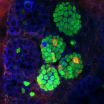(Press-News.org) URBANA, Ill. – Perched high on the bluffs of the big river valleys in the Midwest are some of the last remnants of never-farmed prairie grasslands. These patches, edged by forest, are slowly being taken over by shrubs. A recent University of Illinois study examined the soil microbes on nine patches, also called "balds," that had varying degrees of shrub invasion and found an interesting shift in the composition of the microbial community.
"When we looked at the soil samples from a lightly encroached hill prairie remnant, it was very clear that there was a set of fungi that look like grassland fungi, a set of fungi that look like tree fungi, and the shrubs between the two have some features of both," said U of I microbial ecologist Tony Yannarell. "As the degree of shrub encroachment increased, the amount of change in the fungal communities also increased, and as the degree of shrub encroachment increased, that shrub fungi joined the forest group to become one big woody community."
Yannarell said that on the balds that were completely encroached, the soil samples across the entire remnant were the same. "You get this shift toward woody fungal communities that mirror how much shrub density you have in the hill prairie," he said.
Yannarell said that forest and prairie microbial communities are always very different from each other even in this case where they are only a couple of meters apart. And because of the close proximity, with the same overall climate conditions and soil origin, they could rule out a lot of factors that would normally affect a change in microbial community structure.
The microbes in the shrub soil tend to be different, but different parts of the microbial community change in relationship to the shrub, to the forest, to the prairie. The shrub bacteria are more like what they found in open prairie than in the forest. But the shrub fungi looked a lot more like the forest fungi.
"We think what we found is the signature of these early changes, these early shifts of microbial communities toward a woody fungal community," Yannarell said. "This first study only reveals one side of the change. We think we can firmly conclude that there are some woody, plant-liking fungi. But we don't know if they are enhancing the invasion of it. They could be holding it back if there are shrub diseases.
"We're also interested in knowing if the shrubs have changed these microbes because that could have an effect on a landowner's ability to restore a heavily encroached hill prairie," Yannarell said. "If you cut down all of the shrubs, you haven't changed the microbial communities that live in the soil that the shrubs created. We want to know if those shrubby communities can be invaded by grasses or have they changed something fundamentally so that it will be harder to restore the prairie," he said.
Yannarell explained that the remnant hill prairies are on portions of the bluffs where the soil is erodible, and because it is facing the sun for more of the year, it's slightly warmer and slightly drier. More frequent fires would tip the balance toward grassland, but fires have been suppressed for many decades in the area because people live and farm nearby. The hill prairies are shrinking as the forest, and now native shrubs, such as dogwood, sumac, shrubby black locust, and eventually red cedar move in.
"We don't know yet what kind of long-term impact this could have on the environment," Yannarell said. "As the environment becomes unfavorable for certain microbes, those microbes will die off," he said. "The shrubs could be driving out grass-loving fungi in favor of shrub-loving fungi. It's yet another example of a monoculture taking over."
Yannarell said that this research will be the foundation for a lot of work they'll do in the future.
INFORMATION:
"Influence of Shrub Encroachment on the Soil Microbial Community Composition of Remnant Hill Prairies" was published in the February 2014 issue of Microbial Ecology. Contributing authors were Sarah E. Menning and Alyssa M. Beck.
Funding for this research was provided by the National Great Rivers Research and Educational Center.
Soil microbes shift as shrubs invade remnant hill prairies
2014-03-11
ELSE PRESS RELEASES FROM THIS DATE:
Tracking neighborhood eating habits to promote healthier diets
2014-03-11
Poor food choices, such as overconsumption of carbonated soft drinks, are an important factor driving the global obesity epidemic and have been linked directly to diabetes and heart disease. While public health agencies are working to help people to make healthier choices, monitoring the effectiveness of these efforts has been costly and difficult. But now, using the same digital data employed by marketers to promote food products, McGill University's David Buckeridge has developed a way for health agencies to track Montreal consumers' food choices, neighborhood by neighborhood. ...
NASA saw some power in Tropical Cyclone Gillian before making landfall
2014-03-11
VIDEO:
The TRMM Satellite's Precipitation Radar data was used to create this 3-D flyby over Tropical Cyclone Gillian on March 10. Some powerful storms within Gillian reached heights above 16 km/~9.9...
Click here for more information.
NASA's TRMM satellite saw some towering thunderstorms in Tropical Cyclone Gillian before it made landfall over the Western Cape York Peninsula of Queensland, Australia. Gillian has been staying over land since, and is now a remnant low pressure area. ...
Higher levels of CSF alpha-synuclein predict faster cognitive loss in Parkinson disease
2014-03-11
Philadelphia, PA, March 11, 2014 – The course of Parkinson disease (PD) can vary from gradual deterioration to precipitous decline in motor or cognitive function. Therefore identifying predictors of progression can benefit understanding of PD disease progression and impact management. Data from 304 PD patients followed for up to 8 years indicate that patients with higher cerebrospinal fluid (CSF) alpha-synuclein levels experienced faster cognitive decline in the following months, although no associations were found between alpha-synuclein levels and motor changes. The results ...
Cellular alchemy: Penn study shows how to make insulin-producing cells from gut cells
2014-03-11
PHILADELPHIA — Destruction of insulin-producing beta cells in the pancreas is at the heart of type 1 and type 2 diabetes. "We are looking for ways to make new beta cells for these patients to one day replace daily insulin injections," says Ben Stanger, MD, PhD, assistant professor of Medicine in the Division of Gastroenterology, Perelman School of Medicine at the University of Pennsylvania. Transplanting islet cells to restore normal blood sugar levels in patients with severe type 1 diabetes is one approach to treating the disease, and using stem cells to create beta cells ...
Gesturing with hands is a powerful tool for children's math learning
2014-03-11
Children who use their hands to gesture during a math lesson gain a deep understanding of the problems they are taught, according to new research from University of Chicago's Department of Psychology.
Previous research has found that gestures can help children learn. This study in particular was designed to answer whether abstract gesture can support generalization beyond a particular problem and whether abstract gesture is a more effective teaching tool than concrete action.
"We found that acting gave children a relatively shallow understanding of a novel math concept, ...
Education boosts brain function long after school
2014-03-11
European populations are growing older on average, a trend that could pose serious challenges to health care, budgets, and economic growth. As a greater proportion of a country's population grows into old age, average cognition levels and national productivity tend to decline, and the incidence of dementia increases.
"Finding ways to improve the cognition of seniors is of central importance to the economic well-being of aging countries," says IIASA researcher Vegard Skirbekk, who worked on the study with researchers Nicole Schneeweis and Rudolf Winter Ebmer at Linz University
The ...
Researchers closer to improving safety, effectiveness of lithium therapy
2014-03-11
Tampa, FL (March 11, 2014) – Lithium, one of the oldest and most widely used drugs to treat neuropsychiatric illnesses, such as bipolar disorder, has a serious drawback – toxicity. In a continued effort to find a safer form of lithium, researchers at the University of South Florida (USF) have discovered that lithium salicylate, an alternative salt form, might be the answer.
The researchers found that oral lithium salicylate produced steady lithium levels up to 48 hours in rats without the toxic spike associated with the rapid absorption of current FDA-approved lithium ...
What's the upside of feeling too sad for chocolate?
2014-03-11
The instant gratification and the pleasure derived from consuming excessive chocolate and deep-fried foods can lead way to a double-edged sword of negative consequences ranging from weight gain to feelings of low self-esteem. According to a new study in the Journal of Consumer Research, combating this type of self-destructive behavior may be achieved simply by making a person feel sad.
"We found that when people who are sad are exposed to pictures of indulgent food or indulgent words, their sadness highlights the negative consequences of indulging and encourages them ...
Restoring order in the brain
2014-03-11
Alzheimer's disease is the most widespread degenerative neurological disorder in the world. Over five million Americans live with it, and one in three senior citizens will die with the disease or a similar form of dementia. While memory loss is a common symptom of Alzheimer's, other behavioral manifestations — depression, loss of inhibition, delusions, agitation, anxiety, and aggression — can be even more challenging for victims and their families to live with.
Now Prof. Daniel Offen and Dr. Adi Shruster of Tel Aviv University's Sackler School of Medicine have discovered ...
Time versus money? Placing a value on buyer's remorse
2014-03-11
From a product's price to its convenience, ease of use, and number of overall features, many factors play into getting the most "bang for your buck." According to a new study in the Journal of Consumer Research, when it comes to weighing tradeoffs, selecting something more expensive based on perceived value might lead to buyer's remorse in the long run.
"We propose that when making an immediate decision between complexity and convenience, consumers believe that products with more features and functions represent higher value, even if the complex product might lead to ...




